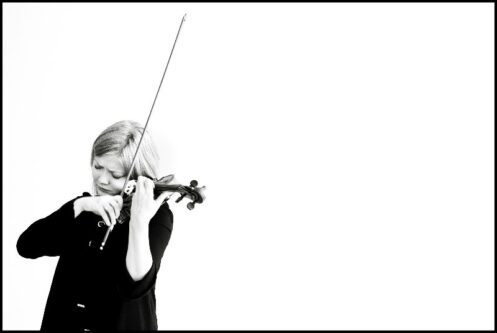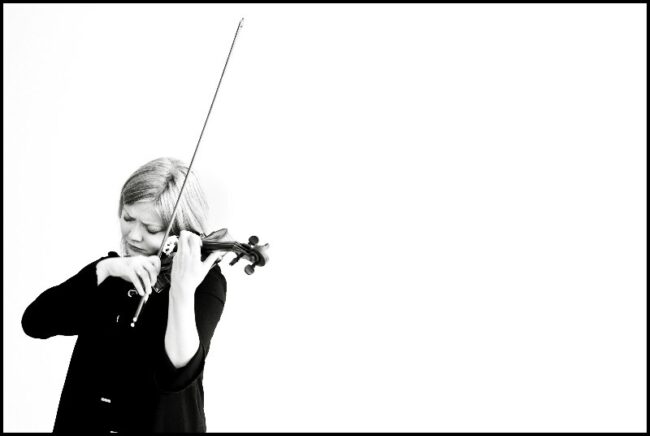 United Kingdom Ysaÿe, Paganini, Berio, Biber, Bartók: Alina Ibragimova (violin). Wigmore Hall, London, 1.7.2022. (CS)
United Kingdom Ysaÿe, Paganini, Berio, Biber, Bartók: Alina Ibragimova (violin). Wigmore Hall, London, 1.7.2022. (CS)

Eugène Ysaÿe – Violin Sonata in G, ‘Pastorale’ (dedicated to Mathieu Crickboom) Op.27 No.5
Nicolò Paganini – Caprice in B flat Op.1 No.13, Caprice in E flat Op.1 No.19, Caprice in A minor Op.1 No.24
Luciano Berio – Sequenza VIII
Heinrich Biber – Passacaglia in G minor, ‘The Guardian Angel’
Béla Bartók – Sonata for solo violin BB124
A recital of music for unaccompanied violin inevitably puts technique and virtuosity in the spotlight but there’s always a risk that flash-and-dazzle bravura may hold sway, making the scope of the music feel somewhat limited, however impressive the playing. During Alina Ibragimova’s Wigmore Hall programme, however, it was imagination and insight that were to the fore. Yes, at times there was fire and fury, sometimes a quasi-brutal ferocity; there was nothing in this fiendishly challenging repertoire that Ibragimova couldn’t deliver with grandeur and ease. But, it was the intellectual focus, architectural sweep and sheer beauty of the sound that held the Hall spellbound and made virtuosity the unassuming servant of the music’s expressive poetry.
Ibragimova began with the fifth of the six solo sonatas that Eugène Ysaÿe wrote for his instrument in 1924, as his own illustrious playing career came to an end and he turned his attention to composition. He reputedly penned the set in just 24 hours after hearing a performance of one of Bach’s solo sonatas by the Hungarian violinist Joseph Szigeti. Each is dedicated to, and reflects the playing style of, a contemporary violinist, and each is both an engagement with the musical past – blending Baroque traditions with the more modern virtuosity of Paganini and others – and a statement of Ysaÿe’s own aesthetic identity. The fifth sonata is dedicated to Ysaÿe’s friend, compatriot and colleague Mathieu Crickboom. The first movement, ‘L’aurore’, is an impressionistic evocation of dawn and at the start Ibragimova dared to gesture the quietest wisps and fragments, gradually allowing her instrument to ‘open up’, sudden left-hand pizzicato injecting vigour, string-sweeping arpeggios imbuing richness and colour, the tone ever fuller and always even, a sense of jouissance being conjured at the close by the expansive juxtaposition of an intense low G string and assertive climbs to the top. The following ‘Danse rustique’ brimmed with rhythmic vivaciousness, the repeated down-bows strokes in the lowest part of the bow thrillingly incisive but the carefree melody always singing. Ibragimova, always so astonishingly focused, was already smiling as she whipped through the final phrase with a joyful relaxation of the intensity.
During the first pandemic lockdown in 2020, Ibragimova set herself the task of doing ‘some serious work’ on Paganini’s 24 Caprices, releasing the recording of the Op.1 set that she made in London’s Henry Wood Hall that June on the Hyperion label the following year. ‘Serious work’ indeed, to judge by the three Caprices that we heard here, performed from memory, every one of the thousands of finger-twisting notes, each of the myriad gestures, colours and textures, delivered with absolute control and sureness of intent. The thirteenth Caprice is sometimes nicknamed ‘The Devil’s Laughter’ but Ibragimova made the sliding thirds – quiet, delicate and ironically sweet of tone – more of a sneering smirk, the leer becoming darker and fiercer in the leaping octave episode, accents biting, the final cadence seeming to erupt with previously contained anger. The agility and abandon with which she flung her left hand up the G-string in the crazy acrobatics of the nineteenth Caprice was almost shockingly audacious, while there was a slightly whimsical air at the start of the famous twenty-fourth Caprice, creating an improvisational spirit which had perhaps been absent in the disciplined authority of the preceding two movements – a lovely rubato and spaciousness for the statement of the theme which gave way to a miscellany of characters and colours, from spidery wispiness to assertive grandeur. This was brilliant music story-telling – mercurial, electric, magisterial.
It’s difficult for any music for unaccompanied violin to escape the shadow of J.S. Bach, and most particularly the D minor Chaconne from the second Partita. Berio’s Sequenza VIII was conceived as a homage to that Chaconne, which the composer declared ‘the high point in which past, present and future violin technologies co-exist’. Ibragimova’s performance of Berio’s knotty journeying was almost frighteningly focused as she totally immersed herself in, and worked through, the composer’s exploratory processes. She seemed to physically ‘bend’ into the notes, searching for some essence at the core of the sound, drawing the listener into a musical argument that sometimes felt almost dangerously probing and contentious. Whether whirring through the toccata-like episodes, scrubbing the strings wildly with two inches of bow-hair at the heel, scurrying with spindly brush-strokes on the string, plucking with the left-hand while simultaneously placing a mute on the bridge, Ibragimova did not neglect the underlying lyricism of the music. Melody was never absent. There was not a sound that was not beautiful. The pianissimo ending – two opposing notes forming a defiant dissonance that refuses to be resolved – was supremely controlled.
There was a similar ‘purity’ at the start of Heinrich Biber’s ‘The Guardian Angel’, each of the four descending notes which form the passacaglia theme enunciated with deliberation and care. Playing with minimal vibrato, Ibragimova gradually ratcheted up the tension as she moved through the variations, the voice-leading clear, the details finely drawn, the filigree delicate but driven, the drama robust. She made the work sound surprisingly ‘modern’ and there was the same sense of deeply considered detail in the final work, Béla Bartók’s spare, haunting sonata for solo violin, written when the composer was dying of leukaemia. As always, Ibragimova – once more playing from memory – made this harrowing work her own, from the bravura of the chaconne-like opening, through the uncompromising intensity of the highest flights; on into the edgy fugue, in which the arguments were both taut and fierce; through the improvisatory searching of the Melodia in which the music seemed to be meandering its own way through a maze of the imagination, finding peace in its own soft mysteries; and finally reaching the perpetuum mobile that burned itself out with explosive exuberance.
Ibragimova’s technique is flawless, but it was not her virtuosity, rather her immersion in a quest for the music’s ‘meaning’ and her commitment to expressing her understanding through the medium of her violin that was most compelling during this recital. With modesty and honesty, she created a persuasive continuum between the diverse works, drawing the Wigmore Hall audience into the musical world that she so compellingly sculpted.
Claire Seymour
